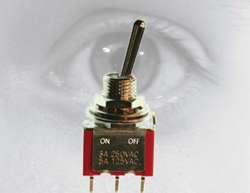Switching night vision on or off

Neurobiologists at the Friedrich Miescher Institute have been able to dissect a mechanism in the retina that facilitates our ability to see both in the dark and in the light. They identified a cellular switch that activates distinct neuronal circuits at a defined light level. The switch cells of the retina act quickly and reliably to turn on and off computations suited specifically for vision in low and high light levels thus facilitating the transition from night to day vision. The scientists have published their results online in Neuron.
"It was fascinating to see how modern neurobiological methods allowed us to answer a question about vision that has been controversially discussed for the last 50 years", said Karl Farrow, postdoctoral fellow in Botond Roska's group at the Friedrich Miescher Institute for Biomedical Research. Since the late 1950 scientists debated how the retina handles the different visual processes at low and high light intensities, at starlight and at daylight. Farrow and his colleagues have now identified a cellular switch in the retina that controls perception during these two settings.
At first glance, everything seems clear. The interplay of two photoreceptor types in the retina, the rods and the cones, allow us to see across a wide range of light intensities. The rods are highly sensitive and spring into action in the dark; the cones are activated during the day and in humans come in three diversities allowing us to see color. The rods help us detect objects during the night; while the cones allow us to discriminate the fine details of those objects during the day. The plethora of initial signals originating from the photoreceptors is computed in a system of only approximately 20 neuronal channels that transport information to the brain. The relay stations are the roughly 20 types of ganglion cells in the retina. How they manage the transition from light to dark and enable vision at the different light regimes has remained unclear.
In the retina several cell layers are stacked on top of each other. The photoreceptors are the first to be activated by light; they relay the information to bipolar cells, which in turn activate ganglion cells. The different types of ganglion cells take on distinct tasks during vision. These ganglion cells are embedded in a mesh of amacrine cells that modulate their activity. "Here is where our new genetic tools proofed very helpful," said Farrow, "because they allowed us to look at individual ganglion cell types and to specifically measure their activities at different light intensities." Farrow and colleagues could thus show that the activity of one particular type of ganglion cells, called PV1, is modulated like a switch by amacrine cells. The amacrine cells inhibit the ganglion cell strongly at high light intensities and weakly at low ambient light levels. This switch is abrupt and reversible and it occurs at the light intensities where cones are starting to be activated. "We were surprised to see how fast this switch occurs and how reliable we were able to switch between the two states at defined light intensities", comments Farrow.
While the above experiments were done in a mouse model, the FMI neurobiologists could show that a similar switch operates in human vision. Their volunteers had to look at narrow and broader stripes at different light levels. They could show that there again a switch operates. While the general ability to see all striped patterns improved with increasing light intensity, suddenly, at a certain light level, the volunteers were much better able to detect thinner patterns as compared to the broader ones. Interestingly enough this switch happened at precisely the light level where the volunteers were also able to discriminate between red and blue, hence where the cones spring into action. "We think we have found a regulatory principle that could apply to several processes in the brain", said Roska, "This principle could explain some situations when gradual changes in the sensory environment leads to abrupt changes in brain computations and perception"
More information: Farrow, K. et al. (2013) Ambient illumination toggles a neuronal circuit switch in the retina and visual perception at cone threshold. Neuron 78.




















